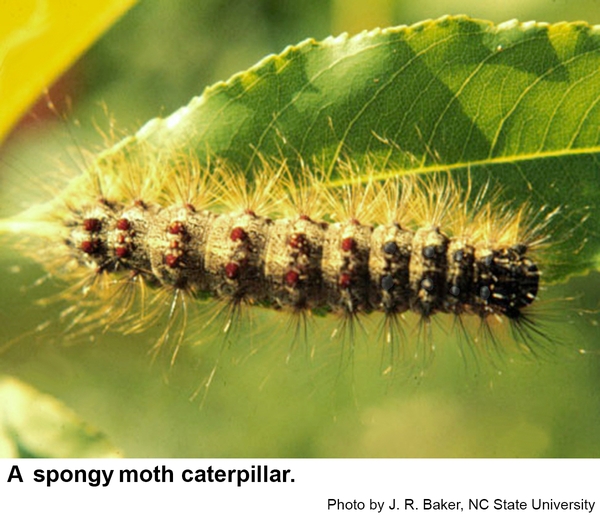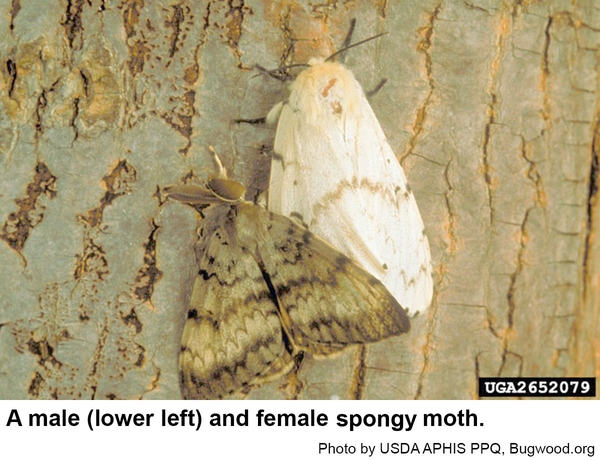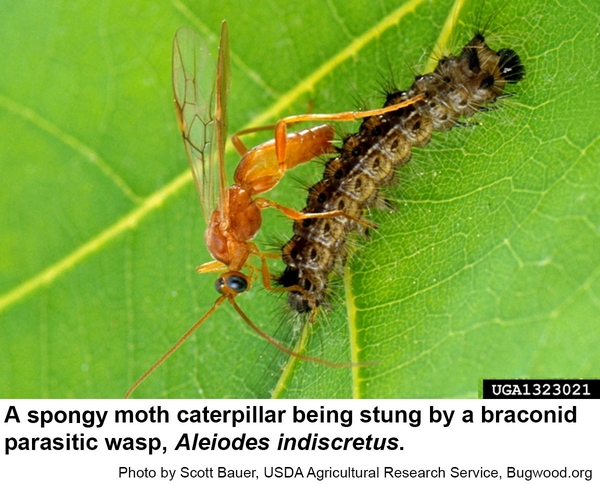Description and Biology
Spongy moth caterpillars, Lymantria dispar, are serious pests of forest and shade trees, as well as a nuisance to people. This hairy caterpillar has characteristic pairs of blue dots followed by pairs of red dots along its back. The male moth is a active flier and mates with winged but flightless females. Male moths are dark and marked with lines and spots. Female moths are pale with darker irregular lines and spots. Older females may loose their darker markings. Each female lays one mass of several hundred eggs obscured by tannish scales. Egg masses are attached to trees, buildings, campers, trailers, yard furniture, or anything that is within crawling distance. Eggs survive the rest of the summer, fall, and winter. Eggs hatch in March (coastal plain) to May (mountains). Young caterpillars cause little noticeable feeding. Very young caterpillars sometimes “balloon” by dropping down on a silk strand that may be blown up to 40 miles! Older caterpillar consume lots of leaves and excrete obnoxious amounts of green pellets (frass) that soon turn reddish brown. Frass sometimes accumulates like a mulch under infested trees. After feeding for a few weeks, caterpillars pupate. Pupae are dark brown with scraggly golden hairs along the sides. Later moths emerge from the pupae and fly in June and July (coastal plain) to July and September (mountains).
Host Plants
Alder, apple, aspen, basswood, birch, boxelder, mountain ash, all types of oaks, and sweet gum are preferred hosts. Older spongy moths also feed on beech, blueberry, chestnut, hemlock, locust, maple, pine, and spruce. They never seem to feed on arborvitae, ash, azalea, balsam fir, butternut, cedar, dogwood, elder, grape, holly, honeysuckle, horse chestnut, juniper, sycamore, and tulip poplar (tulip tree or yellow poplar). Repeated defoliations can seriously weaken and eventually kill some trees. Heavy infestations can restrict outdoor activities because of the large number of caterpillars, constant rain or droppings and the odor of decaying caterpillars. The problem always seems to be worst when the insect is first introduced into an area.
Residential Recommendations
Egg masses, caterpillars or pupae can be accidentally moved from infested areas on campers and other outdoor items. To prevent spread of the spongy moth into or around the state, all vehicles and outdoor articles moving from infested areas should be checked for hitchhiking spongy moth stages. Although a number of pesticides are labeled for gypsy moth caterpillars, should one find the caterpillars, it is highly recommended that the North Carolina Forest Service be notified immediately (1-800-206-9333). This insect is under quarantine in North Carolina, and all infestations outside the quarantine area (Currituck and Dare Counties) should be eradicated.
References
- Managing gypsy moths in North Carolina. Andresen, M. 2013. North Carolina Forest Service Blog.
- Gypsy Moth Program Manual. Anonymous. 2010. United States Department of Agriculture, Animal and Plant Health Inspection Service, Plant Protection and Quarantine. 274 pp.
- Plant Industry - Plant Protection Section, Entomological Services - Gypsy Moth Program. Ballantyne, Allison. 2021. NCDA&CS Plant Industry Division - Plant Protection Section.
- Extension Plant Pathology Publications and Factsheets
- Horticultural Science Publications
- North Carolina Agricultural Chemicals Manual
For assistance with a specific problem, contact your local N.C. Cooperative Extension Center.
This Factsheet has not been peer reviewed.
Publication date: Feb. 28, 2017
Reviewed/Revised: May 13, 2024
Recommendations for the use of agricultural chemicals are included in this publication as a convenience to the reader. The use of brand names and any mention or listing of commercial products or services in this publication does not imply endorsement by NC State University or N.C. A&T State University nor discrimination against similar products or services not mentioned. Individuals who use agricultural chemicals are responsible for ensuring that the intended use complies with current regulations and conforms to the product label. Be sure to obtain current information about usage regulations and examine a current product label before applying any chemical. For assistance, contact your local N.C. Cooperative Extension county center.
N.C. Cooperative Extension prohibits discrimination and harassment regardless of age, color, disability, family and marital status, gender identity, national origin, political beliefs, race, religion, sex (including pregnancy), sexual orientation and veteran status.






